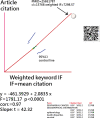The model of descriptive, diagnostic, predictive, and prescriptive analytics on 100 top-cited articles of nasopharyngeal carcinoma from 2013 to 2022: Bibliometric analysis
- PMID: 36820592
- PMCID: PMC9907932
- DOI: 10.1097/MD.0000000000032824
The model of descriptive, diagnostic, predictive, and prescriptive analytics on 100 top-cited articles of nasopharyngeal carcinoma from 2013 to 2022: Bibliometric analysis
Abstract
Background: Nasopharyngeal carcinomas (NPCs) are prevalent in southeast Asia. There is a need to systematically review the current trend and status of NPC research. However, most bibliometric analyses have tended to focus on descriptive and diagnostic analytics rather than predictive and prescriptive analyses. Thus, it is necessary to use the model of the 4 (called the descriptive, diagnostic, predictive, and prescriptive analytics [DDPP]) to derive insights from the data. This study aimed to apply the DDPP model to classify article themes and illustrate the characteristics of NPCs; compare NPC researcher achievements across countries, institutes, departments, and authors; determine whether the mean citations of keywords can be used to predict article citations; and highlight articles that are worthy of reading.
Methods: The Web of Science Core Collection was searched for 100 top-cited articles and reviews related to NPCs published between 2013 and 2022. As part of Microsoft Office Excel 2019, Visual Basic for Applications was used to illustrate the number of publications and scientific productivity of authors over time and to generate network/temporal heatmaps, chord/Sankey diagrams, radar/impact beam plots, and scatter/pyramid charts about collaborations among countries. The DDPP model identifies institutions, authors, and hotspots of NPC research. The category, journal, authorship, and L-index (CJAL) score was applied to evaluate individual research achievements.
Results: A total of 10,564 publications were extracted from Web of Science Core Collection and screened for 100 top-cited articles and reviews related to NPCs. Despite having the highest number of publications (36%), China lags slightly behind the US in CJAL scores. CJAL was higher at Sun Yat-Sen University, Radiat Oncol department, and author Jun Ma from China. The number of article citations was significantly correlated with the number of weighted keywords (F = 1791.17; P < .0001). Six articles with significantly increasing citations over the last 4 years were recommended.
Conclusion: This bibliometric study utilizes the DDPP model to analyze the scientific progress of NPC over the past decade. The whole genome is a hot topic that may prove to be a promising research area in the future. A temporal heatmap may serve as a tool for providing readers with articles that are worth reading, which could lead to additional research in bibliometrics.
Copyright © 2023 the Author(s). Published by Wolters Kluwer Health, Inc.
Conflict of interest statement
The authors have no conflicts of interest to disclose.
Figures









References
-
- Chen Y-P, Chan ATC, Le Q-T, et al. . Nasopharyngeal carcinoma. Lancet. 2019;394:64–80. - PubMed
-
- Bray F, Ferlay J, Soerjomataram I, et al. . Global cancer statistics 2018: GLOBOCAN estimates of incidence and mortality worldwide for 36 cancers in 185 countries. CA Cancer J Clin. 2018;68:394–424. - PubMed
-
- Chen W, Zheng R, Baade PD, et al. . Cancer statistics in China, 2015. CA Cancer J Clin. 2016;66:115–32. - PubMed
MeSH terms
LinkOut - more resources
Full Text Sources
Research Materials
Miscellaneous

